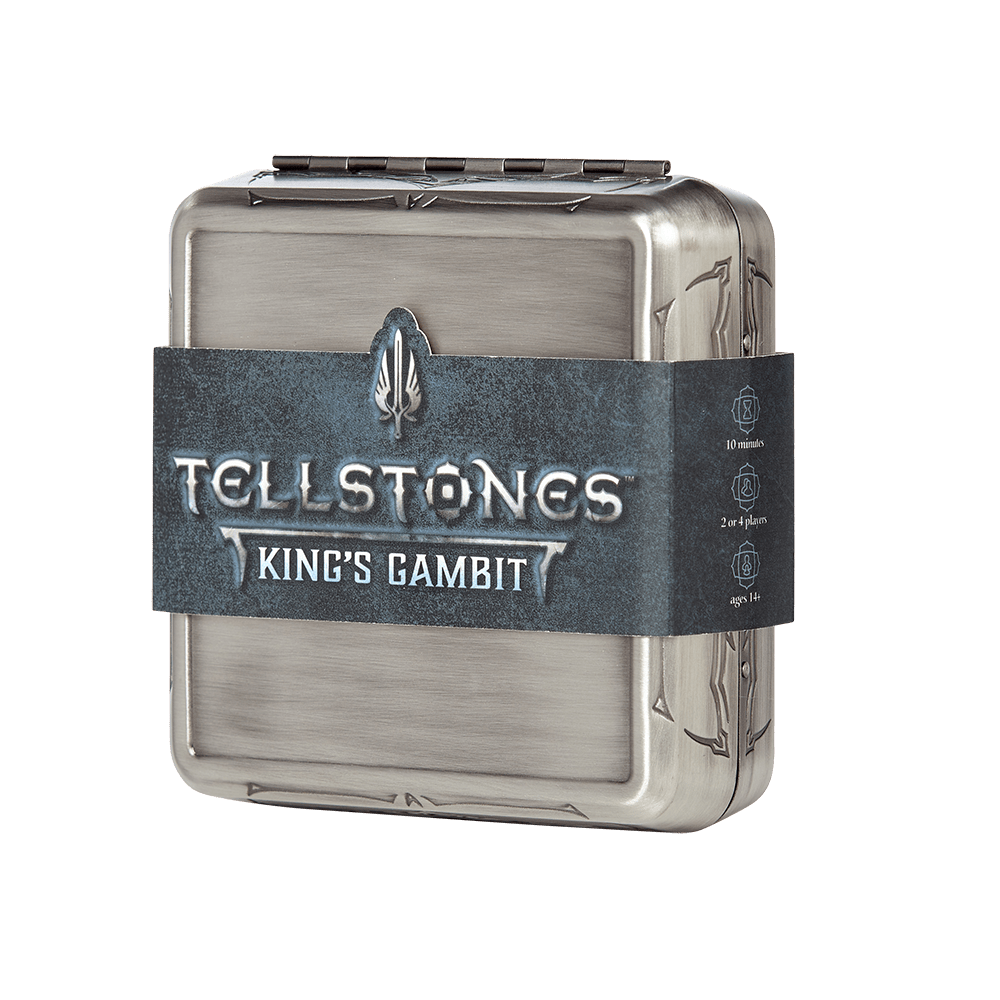The box for Riot Games’ Tellstones: King’s Gambit made me say wow.

Just for clarity, I’m not talking about some old school computer game that has a box of its own rather than a digital download shelf on a launcher; I’m talking about a tabletop game. Riot Games is ramping up their tabletop games activity. Could be huge, right?
Tellstones comes in a metal case. The box is petite. It looks like something you could tuck into your rucksack before heading off to spend a week in a field for a fantasy LARP and without any concern of it getting rained on or dog eared.
I predict some gamers are going to do just that. You see, once you get to that fantasy LARP then Tellstones: King’s Gambit is precisely the sort of in-world game that characters could play there.
Inside that metal case, there are seven wonderfully tactile ivory-coloured disks. There are two beads, rules and a lovely strip of cloth for the playing area. It looks like a small pendant.
Playing Tellstones
Now for the bad news, as much as I was impressed at the simple playability of King’s Gambit and it’s production value; I’m terrible at the game. It’s a memory game. If I knew before I started to play the game that my memory was this bad, then I had clearly forgotten about it.
Tellstones: King’s Gambit is amazingly easy to learn. Players take turns either placing new tokens, one of those seven disks, on the playing area, flipping them over to obscure the unique symbol or re-arranging them. That’s right; your task is to remember where the hidden sigils have gone.

Or, if you choose not to mess with the Tellstones, then you can point at a hidden one and challenge your opponent to name it. If they can, then they score a point; otherwise, you score, and the first to three points wins.
There’s one last complication. Rather than challenge your rival to name a single hidden Tellstone, you can boast that you can call them all out, getting each one’s symbol and position right.
If you make this boast, then your opponent can cede straight away, and you score a point. However, they may also call your bluff and if they do then the whole game is up for grabs. If you fail to live up to your boast, then you immediately lose. Lastly, they could shrug off you boast and take it on themselves to identify all the hidden stones and their positions. If they get this right, then they win, which means it’s hazardous triggering this option as your rival always gets the first chance to scoop the game.
That’s it. Simple. Effective. Embarrassingly deadly. A memory duel.
Riot Games even ran a so-called teaser video for the tabletop game that effectively showed the whole game and even some tactics off. It was hiding in plain sight.
There is a four-player variant in which there are two teams of two, and the game gets more complicated as you might need to factor in your team mate’s ability to remember your mischievous moves, but it’s essentially the same strategies.
I think it’s fair to say that Tellstones: King’s Gambit can be taught in 5 minutes. My games with it have been brutally brief, over in just minutes, as some fast play to load up the playing area, hide stones and shuffle them around always results in one player realising they have the upper hand. Merciless victory always follows swiftly afterwards.
Fantasy worlds
It’s not such a great epiphany of mine that Tellstones: King’s Gambit could come with you to LARPs or even be a moment of drama in a tabletop RPG when an actual game is revealed.
Why not? Well, Tellstones is conceived to be an in-game game for Runeterra.
Runeterra is Riot Games’ setting for their hugely popular League of Legends, Wild Rift and Legends of Runeterra.
In particular, Tellstones: King’s Gambit is the variant of the game played in the region of Demacia. That’s a part of Runeterra known for its knights, chivalric duty and honour.
The symbols on the Tellstones reflect this in-game atmosphere; The Crown, The Flag, The Shield, The Sword, The Knight, The Hammer and The Scales.
I’m pleased to say that all these illustrations are suitably different. No two looks the same.
I’ve leaned on the beauty shots from the games’ blogger info pack for this review but here’s an actual photo of one of the Geek Native playthroughs just to prove that the real game is as lovely, and as easy to read, as the professional shots.

Overall
Despite being dreadful at the game (which is usually a sure-fire way to make me hate it), I’m delighted at Tellstones: King’s Gambit.
It’s a fast game to learn and a quick game to play. I found that we’d play Tellstones two or three times in a row, generally between other board games in an evening session.
It really is a duel.
You could, I think, play Tellstones to determine who pays for the next round of drinks in the conference bar.
Tellstones: King’s Gambit is available from today, and I think it marks the beginning of Riot Games as a force in tabletop games.

